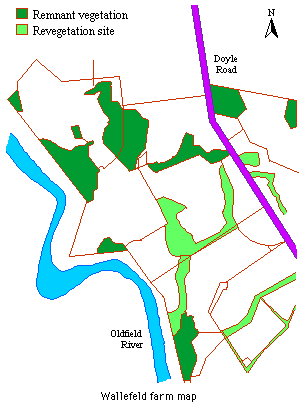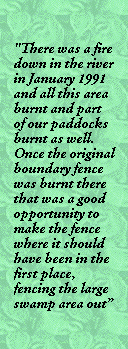
Brigitte Wallefeld, Doyle Road, Munglinup

|
Oldfield River tributary protection
Brigitte Wallefeld, Doyle Road, Munglinup |
 |
 Background
Background
Brigitte and William Wallefeld moved to Munglinup from Germany in 1983 and purchased Location 750 and began farming. When the Wallefelds first moved to the district they had to learn about farming in Australian conditions. "When we first came from Germany it was all very, very different and we had to learn about agriculture in Australia.... which we didn't know a lot about; we didn't know anything about sheep. We only knew cattle. Well we learned by doing and making our mistakes but having lots of good neighbours and advice here that helped us along". Since then they have been protecting the creeks on the property and Brigitte is an active member of the Oldfield Catchment Group. The property is at the confluence of the Munglinup and Oldfield Rivers and has tributaries that run into the Oldfield River. The Problem The Wallefeld's noticed that the creek systems on the farm were becoming degraded and they began fencing and planting trees in 1993. "....and they have done very well apart from a few hiccups and failures earlier on. But that gives us a great pleasure because it has changed the farm, the look of the landscape. Because before everything was bare, and we just accepted this as being that this is just how farms look in Australia. But then with all the wind erosion and water erosion we had we knew we had to do something about that. And we're glad we did". The Solution "Our farm, there was nothing left except 60 hectares of native bush so we had to put everything back in there. Where we had a problem with rising water tables or salinity encroaching onto the creeklines that feed into the river system, we have fenced out the creeklines and revegetated. Or we have fenced out and just stabilised the waterway so that there's no further erosion. Where there is remnant vegetation left close to the river we have fenced it off so that some natural revegetation takes place there. That's mainly what we've done".
The Wallefeld's planted Blue Gums initially, "..... because they were just so good at actually growing. They were just such an instant success and they gave you such a boost". The blue gums were planted in the sandier areas and also along one of the creek arms.
"We were mainly interested in getting a good growth rate for our trees. We've only just, over the last three or four years, gone down the track of looking at more local native species". Prior to planting the areas were sprayed for weeds and deep ripped with most of this being carried out without external funding and labour. However, one of the creek systems adjacent to the Oldfield was fenced using some assistance from the former Water and Rivers Commission. However, the work at this site has not been successful as the soil continues to erode. "It keeps on breaking off and breaking away and it will also break the fence away again. We could do some earthworks there to stop that and then some revegetation. But that would be extremely costly and it's not a very productive area. So it really doesn't make a lot of sense to us doing this now unless maybe someone is interested in giving us some money or doing the earthworks for it but we can't do it. We have fenced out everything but that is as much as we can do". Brigitte believes that some of the property should never have been cleared and these areas have been fenced off to allow for natural regeneration. "All the trees are growing in there and occasionally we can put stock back in there for shelter". Some of the contour banks were sited in the wrong place. "The gully dam is useless for us now because the erosion that was created by putting in contour banks up here has silted this dam up completely. But this is all fenced out now and all revegetated and that has helped with the spot of salinity below the dam area. This area should never have been part of the farm, it still is some old river channel. But the way they surveyed the farms they didn't take any notice of that. We have increased the buffer zone and fenced this off and hopefully it shouldn't still be a problem".
Most of the fencing has resulted in a buffer along the creeklines of 50-150 metres wide. The major creek is approximately 150-200 metres wide and is fenced to include the entire natural waterway. "We looked at the lay of the land and we could see that this is what it would have been. We fenced it that wide because in winter time it was always very, very wet and boggy and you couldn't crop it".
There is a swamp where the Munglinup River joins the Oldfield River and the Wallefeld's have fenced it off. "There was a fire down in the river in January 1991 and all this area burnt and part of our paddocks burnt as well. Once the original boundary fence was burnt there that was a good opportunity to make the fence where it should have been in the first place, fencing the large swamp area out. We increased the area and included a beautiful stand of Munji (Nuytsia floribunda) trees. We had cattle in there one year just to eat the weeds that were in the paddock part of it. The swamp is so thick [now] you wouldn't get in there and the cattle couldn't get in there after the second or third year". The Wallefeld's bought the farm across Doyle Road (Location 749) and noticed signs of salinity where the Munglinup River crosses Doyle Road. Trees were planted but Brigitte noticed that the degraded area was growing. "It has expanded despite the fact that we've planted more trees and fenced out further up in the catchment. The water table must continue to rise there. This is also partly due to the fact that the road is blocking off the natural flow. Behind the road it is silted up so the water has really got nowhere to go. So that's getting worse, so far it's only slightly affecting the main corridor of the Munglinup River. But it probably will in time, if we can't do anything. At the moment it's affecting our trees on our place". Brigitte believes that the site has not found a balance yet and that it also "takes a while before the trees kick in". The Outcomes and observations "We've fenced out all creeklines and waterways now. Which is good so that stops any sediment going down affecting the main channel". Brigitte believes that all the fencing and replanting has had benefits to the farm. "It has stopped erosion, which would have to be a major problem. It gives protection; it can be a windbreak when the trees are big enough. It can also be an area where you can put stock for shelter occasionally. Our farm might be different to most others because we started many, many years ago trying to farm according to soil types. That does change the fencing, if you're running stock you have to rearrange your fencing. That's why we have got paddocks that look extremely funny with trees in between. But I think they provide a windbreak and they provide shelter, and it stops erosion and that is the main benefit. Also in some areas where we had a rising water table problem it keeps it under control. That and the trees, and the perennial pastures that are used on purpose in the recharge areas". Oldfield tributary catchment statistics
Map Reference: 1: 50 000 3030-II |
||||||||||||
 |
|||||||||||||
 |
|||||||||||||